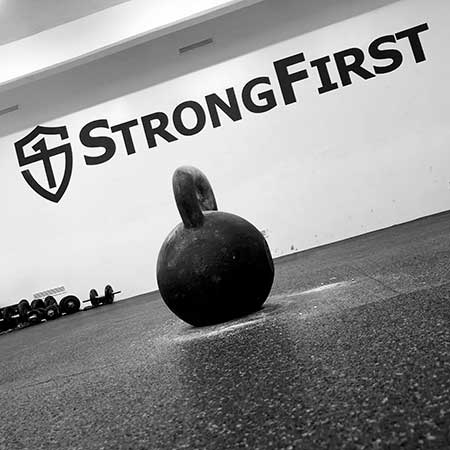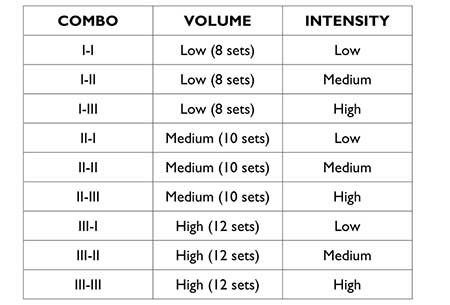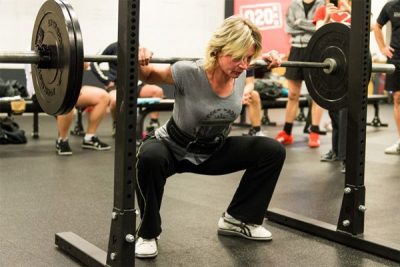
“Each time [the waves] fall, they never fail to rise again.”—Josh Billings
You earned the stripes of “Timed Simple.” You took the time and mastered the weights between Simple and Sinister (40kg for gents both in the swing and the get-up, 28kg in the swing and 20kg in the get-up for the ladies). Now, you qualify for an advanced program.
Pavel writes in the original Kettlebell Simple & Sinister:
For the sake of simplicity, I purposefully removed the equivalent of the safety switch from the S&S program, namely load variability or “waviness,” as Russians call it.
…and later shared an excellent “waved” training template for intermediate lifters on our blog in the article “From Simple to Sinister: Waving Volume on S&S.”
In my article series Kettlebell Simple & Sinister Quest (Part I and Part II), I promised you a training plan based on the principles I learned from Pavel at Plan StrongTM and Strong EnduranceTM, as well as at Fabio’s Built Strong. A program that will get you smoothly to “Timeless Sinister” by waving the volume AND intensity. Here it is.
The wave will go up and down and gradually become a tsunami that will allow you to finally crush your Sinister goal.
“Sometimes, big waves are hidden inside small waves; the revolt of every big storm starts with a small wave!”—Mehmet Murat ildan
Frequency
Shoot for almost daily practice. Three sessions per week should be the minimum, four to five sessions the optimum, and six sessions the maximum. “Strength is a skill,” and the skill needs to be practiced often. I enjoyed S&S practice very much, but at a certain load (due to my light bodyweight) my recovery started to suffer. Waving the volume and intensity allowed me to train often, recover well, and smoothly progress to “Timeless Sinister.”
Volume
For the number of reps, stick to the standard S&S reps. Do sets of 10 reps in the swing and sets of 1 in the get-up.
For the number of sets, you will use 3 volume zones:
The program is biased towards medium volume (10 sets—S&S standard), with occasional lower volume days (8 sets) or higher volume days (12 sets).
Intensity
We will use three intensity zones:
Below are the pairs of weights you will be using, first for gents, and after some explanation, for ladies as well:
Gentlemen, 1st Cycle: From 40kg to 44kg
Gentlemen, 2nd Cycle: From 44kg to 48kg
Explaining the Weight Selection
First cycle: If you can do 100 swings and 10 get-ups with 40kg, you can certainly do 10 swings and 1 get-up per side with 44kg. 44kg will be your “S&S sort-of-max.” 70{32c02201c4e0b91ecf15bfd3deecd875caca8b9615db42cfd45ce3d8de8d0829} of 44kg is 30.8kg—hence the starting (main) weight for the first cycle is 32kg.
Second cycle: If you can do 100 swings and 10 get-ups with 44kg, you can certainly do 10 swings and 1 get-up per side with 48kg. 48kg will be your “S&S sort-of-max.” 70{32c02201c4e0b91ecf15bfd3deecd875caca8b9615db42cfd45ce3d8de8d0829} of 48 kg is 33.6—hence the starting (main) weight for the first cycle is 36kg (well, it is a bit heavier, but hell, close enough).
During both cycles aim for your heavy day to become your medium day and your medium day a light day.
For the ladies who have mastered the in-between weights for “Simple” and “Sinister” (28kg for swings and 20kg for get-ups), there will be only one cycle. If you don’t have the intermediate weights (such as 18kg, 22kg, or 26kg), use the weights in parentheses. Choose carefully by testing the lighter and heavier options. It should be a challenge but not a struggle. Don’t be ashamed of using the lighter kettlebell.
Here are the training weights for ladies:
Ladies: From 28kg to 32kg (Swing)
Ladies: From 20kg to 24kg (Get-up)
How to Gradually Add Weight
Example: During the first 2 weeks of the first cycle, gentlemen will perform just two sets of swings with the target/heavier weight.
10L = 10 reps with left hand, 10R = 10 reps with the right hand.
Session #1
- Volume: Number on die 6 = high volume = 6 sets each side, 12 sets total
- Intensity: Number on die = 3 = medium intensity, i.e., 32kg and 40kg
Session #2
- Volume: Number on die 1 = low volume = 4 sets each side, 8 sets total
- Intensity: Number on die = 4 = high intensity, i.e., 36kg and 44kg
Note: Notice that the number of sets with the target weight is the same, and we cut some sets with the starting weight from “the tail.” Always cut from “the tail.”
Session #3
- Volume: Number on die 3 = medium volume = 5 sets each side, 10 sets total
- Intensity: Number on die = 3 = medium intensity, i.e., 32kg and 40kg
Session #4
- Volume: Number on die 6 = high volume = 6 sets each side, 12 sets total
- Intensity: Number on die = 4 = high intensity, i.e., 36kg and 44kg
Session #5
- Volume: Number on die 4 = medium volume = 5 sets each side, 10 sets total
- Intensity: Number on die = 1 = low intensity, i.e., 28kg and 36kg
Etc.
You will keep practicing for about two weeks, and then add another set on your left and right with the target weights.
Example: During the second 2 weeks of the first cycle, the same gentleman will perform just four sets of swings with the target/heavier weights.
Session #17
- Volume: Number on die 3 = medium volume = 5 sets each side, 10 sets total
- Intensity: Number on die = 3 = medium intensity, i.e., 32kg and 40kg
Session #18
- Volume: Number on die 6 = high volume = 6 sets each side, 12 sets total
- Intensity: Number on die = 4 = high intensity, i.e., 36kg and 44kg
Continue until you get to the first and second set with the starting weight and are completing the remaining sets with the target weight. When you reach all sets with the target weight, keep practicing for about two weeks and then proceed to the next cycle. You will begin the next cycle with a new pair of starting/target weights. Use the new target weights for just two sets (set 5 and 6) at the beginning of the new cycle.
This was a swing example. Apply the same rules to your get-ups, but instead of sets of 10 reps, you are, of course, doing singles: 1L, 1R, etc.
- Run the swing cycle and the get-up cycle independently—you may progress in one or the other lift faster or slower—that’s alright.
- Always determine the volume and intensity for the swing and get-up separately—4 dice throws (or more if you end up in the same volume or intensity zone as the previous session).
- Throw a die to determine the swing volume and swing intensity.
- Throw a die to determine the get-up volume and get-up intensity.
- Every training should have BOTH volume AND intensity for each respective lift that differs from session to session.
- Example: If your last swing session was medium volume—low intensity, today’s session will be low (or high) volume—medium (or high).
- You will end up with one of the nine combinations in the table below. This will make it easier for you to record it in your training diary. The codes of the various combos:
- I, II, and III mean light, medium, and high.
- The first number represents volume and the second intensity.
- None of the two numbers can be the same day-to-day. If you had e.g., I-III for swings, the next session must be volume II or III and the intensity must be I or II.
“When in doubt, simplify.”—Eric Ries

Too Complicated?
It should not be. But if you don’t have access to that many kettlebells, here is a super simple wave program. Not the stormy sea above, but still a wave.
Let’s say you have been following the standard S&S and you progressed from 32kg to 40kg. Instead of starting to climb the hill to 48kg, let the wave fall and rise again. Restart the cycle with 36kg and gradually incorporate 44kg following the standard S&S outlined in Simple & Sinister and our Kettlebell Simple & Sinister Online Course.
After you successfully tackle the 44kg, restart the cycle with 40kg and 48kg. Up and down. Up and down.
Peaking
“Timeless Sinister” is one thing. “Timed Sinister” is another. I was comfortably doing one-arm swings with 56kg, and my first Sinister attempt was still a fail… I mean a lesson.
Make sure you use the right peaking protocol, such as the one developed by StrongFirst Director of Education, Brett Jones featured in our online course.
Enjoy surfing the waves!





















